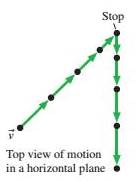
Concept explainers
Problems 49 through 52 show a partial motion diagram. For each:
a. Complete the motion diagram by adding acceleration vectors.
b. Write a physics problem for which this is the correct motion diagram. Be imaginative! Don’t forget to include enough information to make the problem complete and to state clearly what is to be found.
c. Draw a pictorial representation for your problem.
49
FIGURE P1.49

50
FIGURE P1.50

51
FIGURE P1.51

52
FIGURE P1.52

Learn your wayIncludes step-by-step video

Chapter 1 Solutions
PHY F/SCIENTIST MOD MASTERING 24 MO
Additional Science Textbook Solutions
Cosmic Perspective Fundamentals
Organic Chemistry (8th Edition)
Campbell Biology: Concepts & Connections (9th Edition)
Human Biology: Concepts and Current Issues (8th Edition)
Campbell Essential Biology with Physiology (5th Edition)
Applications and Investigations in Earth Science (9th Edition)
- 5.60 An adventurous archaeologist crosses between two rock cliffs by slowly going hand over hand along a rope stretched between the cliffs. He stops to rest at the middle of the rope (Fig. P5.60). The rope will break if the tension in it exceeds 2.50 X 104 N, and our hero's mass is 90.0 kg. (a) If the angle is 10.0°, what is the tension in the rope? (b) What is the smallest value can have if the rope is not to break? Figure P5.60arrow_forwardplease answer the question thanks!arrow_forward5.48 ⚫ A flat (unbanked) curve on a highway has a radius of 170.0 m. A car rounds the curve at a speed of 25.0 m/s. (a) What is the minimum coefficient of static friction that will prevent sliding? (b) Suppose that the highway is icy and the coefficient of static friction between the tires and pavement is only one-third of what you found in part (a). What should be the maximum speed of the car so that it can round the curve safely?arrow_forward
- 5.77 A block with mass m₁ is placed on an inclined plane with slope angle a and is connected to a hanging block with mass m₂ by a cord passing over a small, frictionless pulley (Fig. P5.74). The coef- ficient of static friction is μs, and the coefficient of kinetic friction is Mk. (a) Find the value of m₂ for which the block of mass m₁ moves up the plane at constant speed once it is set in motion. (b) Find the value of m2 for which the block of mass m₁ moves down the plane at constant speed once it is set in motion. (c) For what range of values of m₂ will the blocks remain at rest if they are released from rest?arrow_forward5.78 .. DATA BIO The Flying Leap of a Flea. High-speed motion pictures (3500 frames/second) of a jumping 210 μg flea yielded the data to plot the flea's acceleration as a function of time, as shown in Fig. P5.78. (See "The Flying Leap of the Flea," by M. Rothschild et al., Scientific American, November 1973.) This flea was about 2 mm long and jumped at a nearly vertical takeoff angle. Using the graph, (a) find the initial net external force on the flea. How does it compare to the flea's weight? (b) Find the maximum net external force on this jump- ing flea. When does this maximum force occur? (c) Use the graph to find the flea's maximum speed. Figure P5.78 150 a/g 100 50 1.0 1.5 0.5 Time (ms)arrow_forward5.4 ⚫ BIO Injuries to the Spinal Column. In the treatment of spine injuries, it is often necessary to provide tension along the spi- nal column to stretch the backbone. One device for doing this is the Stryker frame (Fig. E5.4a, next page). A weight W is attached to the patient (sometimes around a neck collar, Fig. E5.4b), and fric- tion between the person's body and the bed prevents sliding. (a) If the coefficient of static friction between a 78.5 kg patient's body and the bed is 0.75, what is the maximum traction force along the spi- nal column that W can provide without causing the patient to slide? (b) Under the conditions of maximum traction, what is the tension in each cable attached to the neck collar? Figure E5.4 (a) (b) W 65° 65°arrow_forward
- The correct answers are a) 367 hours, b) 7.42*10^9 Bq, c) 1.10*10^10 Bq, and d) 7.42*10^9 Bq. Yes I am positve they are correct. Please dont make any math errors to force it to fit. Please dont act like other solutiosn where you vaugley state soemthing and then go thus, *correct answer*. I really want to learn how to properly solve this please.arrow_forwardI. How many significant figures are in the following: 1. 493 = 3 2. .0005 = | 3. 1,000,101 4. 5.00 5. 2.1 × 106 6. 1,000 7. 52.098 8. 0.00008550 9. 21 10.1nx=8.817arrow_forwardplease solve and answer the question correctly please. Thank you!! (Hint in second photo)arrow_forward
 College PhysicsPhysicsISBN:9781938168000Author:Paul Peter Urone, Roger HinrichsPublisher:OpenStax College
College PhysicsPhysicsISBN:9781938168000Author:Paul Peter Urone, Roger HinrichsPublisher:OpenStax College Physics for Scientists and Engineers: Foundations...PhysicsISBN:9781133939146Author:Katz, Debora M.Publisher:Cengage Learning
Physics for Scientists and Engineers: Foundations...PhysicsISBN:9781133939146Author:Katz, Debora M.Publisher:Cengage Learning University Physics Volume 1PhysicsISBN:9781938168277Author:William Moebs, Samuel J. Ling, Jeff SannyPublisher:OpenStax - Rice University
University Physics Volume 1PhysicsISBN:9781938168277Author:William Moebs, Samuel J. Ling, Jeff SannyPublisher:OpenStax - Rice University Physics for Scientists and Engineers with Modern ...PhysicsISBN:9781337553292Author:Raymond A. Serway, John W. JewettPublisher:Cengage Learning
Physics for Scientists and Engineers with Modern ...PhysicsISBN:9781337553292Author:Raymond A. Serway, John W. JewettPublisher:Cengage Learning College PhysicsPhysicsISBN:9781305952300Author:Raymond A. Serway, Chris VuillePublisher:Cengage Learning
College PhysicsPhysicsISBN:9781305952300Author:Raymond A. Serway, Chris VuillePublisher:Cengage Learning Principles of Physics: A Calculus-Based TextPhysicsISBN:9781133104261Author:Raymond A. Serway, John W. JewettPublisher:Cengage Learning
Principles of Physics: A Calculus-Based TextPhysicsISBN:9781133104261Author:Raymond A. Serway, John W. JewettPublisher:Cengage Learning





